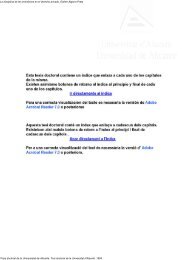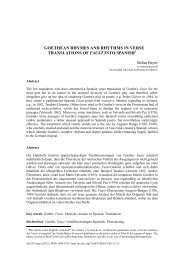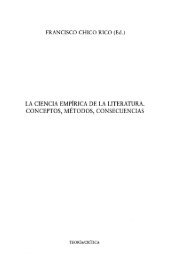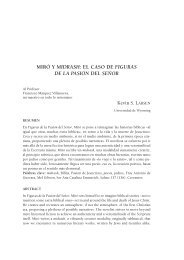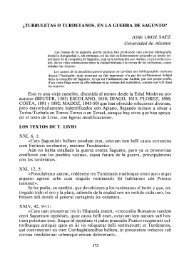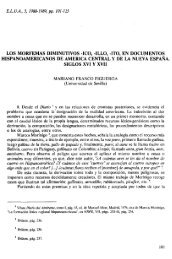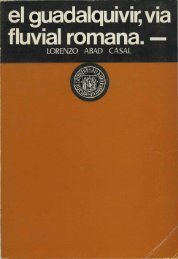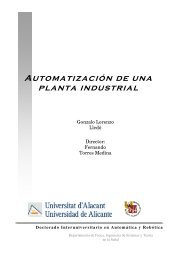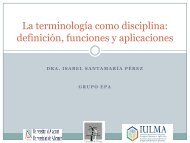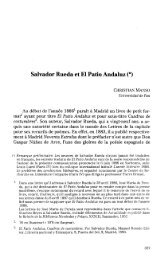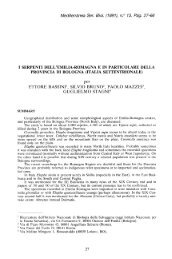ecological effects of marine protected areas empafish project ...
ecological effects of marine protected areas empafish project ...
ecological effects of marine protected areas empafish project ...
You also want an ePaper? Increase the reach of your titles
YUMPU automatically turns print PDFs into web optimized ePapers that Google loves.
EMPAFISH Booklet no. 1 Ecological <strong>effects</strong> <strong>of</strong> Atlanto-Mediterranean MPAs in the EU<br />
through the food web (from primary producers to top-predators, i.e. a<br />
'bottom-up' process), true trophic cascades are generally viewed from the<br />
'top-down' pathway (from top-predators to primary producers). The "true<br />
trophic cascades imply keystone species, with such top-down dominance that<br />
their removal causes precipitous change in the system" (ref). Nevertheless,<br />
the concept <strong>of</strong> 'keystone' species has been given different meanings and<br />
definitions, and has been applied to organisms with very different <strong>effects</strong> on<br />
their communities.<br />
Demonstrating cascading impacts is difficult as reactions down through the<br />
food webs progressively decrease. Depending on the complexity <strong>of</strong> the system<br />
and the specialization <strong>of</strong> the species concerned, changes down the food web<br />
could be highly variable and diffuse. The <strong>effects</strong> <strong>of</strong> removal <strong>of</strong> top-predators<br />
would be weakened down a species-rich system and/or down a system with a<br />
high abundance <strong>of</strong> omnivorous species[or just “a system with abundant<br />
omnivores”]. In an ecosystem, species are interconnected by different types<br />
<strong>of</strong> direct and indirect interactions, the <strong>effects</strong> <strong>of</strong> which are intermingled in the<br />
ecosystem functioning. Direct predator effectiveness is mediated by various<br />
indirect <strong>effects</strong> (shelter availability, heterogeneity <strong>of</strong> habitats, variability <strong>of</strong><br />
recruitment, size refuge, patchiness <strong>of</strong> resources, disease, stochasticity <strong>of</strong><br />
abiotic events) which obscure the pure trophic cascading <strong>effects</strong>. Trophic<br />
cascades generally occur when the runaway consumption flow is unified, i.e.<br />
specifically directed to some kind <strong>of</strong> food. According to the numerous papers<br />
published about trophic cascades in fresh waters ecosystems, we could<br />
hypothesize that a true cascade effect is evident if the number <strong>of</strong> links in the<br />
trophic web is not too large, e.g. when the trophic web is damaged. However,<br />
if the number <strong>of</strong> trophic levels and the number <strong>of</strong> trophic links increase, a<br />
clear trophic cascade effect may probably be impossible to detect.<br />
Consequently, are MPA’s the best places to study cascade <strong>effects</strong>? A strict<br />
banning <strong>of</strong> all fishing pressures in an MPA is likely to allow recovery, not to<br />
pristine conditions, but to a greater species richness and/or trophic diversity<br />
than outside, in un<strong>protected</strong> <strong>areas</strong>. There may therefore be a lower chance <strong>of</strong><br />
detecting <strong>effects</strong> <strong>of</strong> trophic cascades in MPAs, where trophic diversity has<br />
increased.<br />
2.5 The interference <strong>of</strong> habitat structure<br />
In assessing the <strong>effects</strong> <strong>of</strong> MPAs, there is a potential source <strong>of</strong> confounding in<br />
the fact that, usually, <strong>marine</strong> reserves are established in zones that already<br />
harbour structurally complex habitats, which form favourable habitats for the<br />
development <strong>of</strong> a rich and abundant reef fish fauna (García Charton & Pérez-<br />
Ruzafa 1999; García Charton et al. 2000, 2004). Part <strong>of</strong> the observed<br />
variability in fish assemblage structure could be due to selection <strong>of</strong> <strong>areas</strong> to<br />
be <strong>protected</strong> that are particularly favourable to high fish abundance and<br />
diversity, because they <strong>of</strong>fer predominantly rocky, complex habitats.<br />
Nevertheless, the influence <strong>of</strong> habitat structure seems to be exerted mainly at<br />
small-to-intermediate spatial scales, since, isolating the part <strong>of</strong> variation due<br />
to habitat from the variables chosen as indicators <strong>of</strong> the ‘‘reserve effect’’<br />
produces mainly the loss <strong>of</strong> heterogeneity among sectors and/or zones<br />
(García Charton et al. 2004), although in some cases (e.g. Ordines et al.<br />
7



